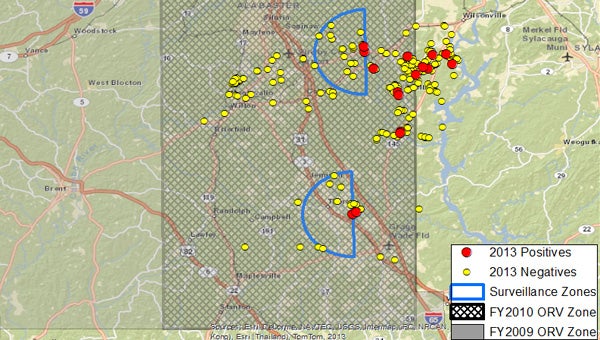State, U.S. officials meet to discuss rabies cases
Published 3:30 pm Thursday, August 1, 2013

Mapped out: This map shows locations where animals have been tested since January for rabies. Red dots indicate locations where animals tested positive.
By Stephanie Brumfield / Shelby County Reporter
There have been three confirmed cases of rabies-infected animals in Chilton County since Jan. 28, and 18 more cases near the county’s borders.
On Wednesday, officials from the United States Department of Agriculture, the Alabama Department of Public Health and local agencies gathered in Pelham to talk solutions.
Officials’ concerns are not with rabies exactly, but rather with where rabies has spread. Typically, raccoon-related rabies cases have been confined to the eastern portion of the United States with the Appalachians serving as the general boundary line, and in Alabama the Coosa River has served as the dividing line between areas with rabies and areas without. With rabies cases now being reported west of the Coosa River, officials are concerned the virus is spreading.
Recent cases
The most recent case of rabies in the area was reported July 24 near the Shelby/Jefferson County line on Alabama 119.
Of the 21 confirmed cases in the Chilton County area since January, two were reported in Clanton, four in the Leeds/Moody area and the remaining 15 in Columbiana and surrounding areas, said Dana Johnson, who works with the Wildlife Services division of the USDA.
One domestic dog, one cat, one red fox and 18 raccoons tested positive for the virus, Johnson said.
The increase in local rabies cases is likely due to a rise in raccoon populations, Johnson said. Raccoons, the main carriers of rabies in the eastern U.S., probably multiplied and moved quietly through unpopulated areas, and now that they have reached more densely populated areas like Columbiana, cases are finally being reported, he said.
Johnson also noted that not all cases of rabies are reported, locally or nationally. Often locals, especially in rural areas, will take matters into their own hands and kill animals without reporting the incident, he said.
Identifying rabies
Not all animals with rabies are ferocious, nor do they necessarily show symptoms, he said. Raccoons are especially notorious for being silent carriers of the virus because of the virus’ long incubation period.
“The best surveillance is when we get calls about strange-acting animals,” said Frank Boyd, state director with USDA Wildlife Services.
Because rabies affects the nervous system, it often causes animals to do things they wouldn’t normally do, Boyd said. Examples of “strange-acting” animals include walking in circles, sitting on a porch for hours without moving, falling over while walking and other out-of-the-ordinary behaviors.
Rabid animals also tend to salivate excessively and exhibit ferocious behavior, though these symptoms do not have to be present for an animal to be infected, Boyd said.






